|
Duane's
Limited Edition Bronze Sculptures are made by hand in the USA.
Bronze
is a metal compound containing copper and other elements such as tin.
Artists have used bronze for creating timeless sculptures since antiquity.
While it is not the cheapest medium to work with, the price of the metal
is not the determining cost factor. Every step in the process is done
by hand and is very time consuming.
How
does he do it?
Before
he can cast the sculpture in bronze, Duane must first create the original
in clay. Depending on the size and complexity, this step alone can take
hundreds of hours. Then, a limited number, typically no more than between
1 up to 399, of bronze sculptures are cast one at a time over a long
period of time (usually years) using the "Lost Wax Method."
"ARMATURE"
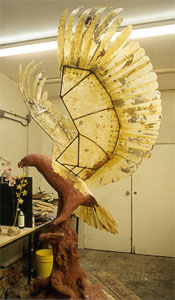 The
initial step is to build an armature, typically out of fiberglass. He
then coats the surface with clay. In this picture of "Day's End,"
you can clearly see the brown clay that Duane has already applied to
the bottom half of the surface of the armature. The
initial step is to build an armature, typically out of fiberglass. He
then coats the surface with clay. In this picture of "Day's End,"
you can clearly see the brown clay that Duane has already applied to
the bottom half of the surface of the armature.
"ORIGINAL
CLAY SCULPTURE"
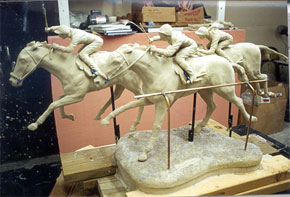
Next he sculpts the intricate detail into the clay. This picture illustrates
the way "Win, Place & Show" looked after he completed
the original clay sculpture.
"MOLD
MAKING"
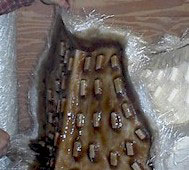 The
finished clay sculpture is sealed and then a release agent is applied
to make it easier to remove the rubber mold later on. Once the original
sculpture has been prepared, the first coat of rubber is applied by
hand. This step is crucial to obtaining the proper level of detail.
The entire sculpture is covered with an even, thin layer of rubber.
Once the initial layer of rubber has set, additional coats are applied
with "keys" which are used to identify the proper position
of the mold when closed. After the rubber has thoroughly set, a back-up
shell or "Mother Mold" is created out of fiberglass to support
the rubber for the wax pouring process. Next the back-up shell is removed
and the rubber pulled gently back so the original clay sculpture can
be removed. It can take more than 100 hours just to make the mold for
elaborate pieces. After the rubber has been cleaned, the mold is ready
to receive the wax. The
finished clay sculpture is sealed and then a release agent is applied
to make it easier to remove the rubber mold later on. Once the original
sculpture has been prepared, the first coat of rubber is applied by
hand. This step is crucial to obtaining the proper level of detail.
The entire sculpture is covered with an even, thin layer of rubber.
Once the initial layer of rubber has set, additional coats are applied
with "keys" which are used to identify the proper position
of the mold when closed. After the rubber has thoroughly set, a back-up
shell or "Mother Mold" is created out of fiberglass to support
the rubber for the wax pouring process. Next the back-up shell is removed
and the rubber pulled gently back so the original clay sculpture can
be removed. It can take more than 100 hours just to make the mold for
elaborate pieces. After the rubber has been cleaned, the mold is ready
to receive the wax.
"WAX
POURING"
 A
wax casting is then made by carefully pouring wax into the mold at 160
degrees Fahrenheit. After the wax has cooled, the back-up shell and
mold are removed. A
wax casting is then made by carefully pouring wax into the mold at 160
degrees Fahrenheit. After the wax has cooled, the back-up shell and
mold are removed.
"WAX
CHASING AND SPRUING"
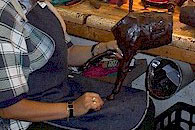 Next
the wax is pulled from the mold and hand chased (re-detailed). Wax rods,
called sprus or gates, are then attached to the sculpture along with
a large cup at one end to allow the molten bronze to be poured into
a ceramic shell which is in effect a "secondary" mold created
for each casting. Next
the wax is pulled from the mold and hand chased (re-detailed). Wax rods,
called sprus or gates, are then attached to the sculpture along with
a large cup at one end to allow the molten bronze to be poured into
a ceramic shell which is in effect a "secondary" mold created
for each casting.
|
"SLURRY
DIPPING"
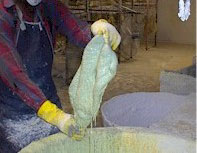 Dipping
the wax in a liquid binder solution, called "slurry", that
hardens as it dries, forms the shell. This step has to be done in a
temperature and humidity controlled room. Since the slurry must be allowed
to dry in between each dipping, this process alone can take a couple
of weeks! Next it is baked in a kiln at 1800 degrees Fahrenheit. As
a result, the wax is "lost" as it melts out of the shell.
After de-waxing, the shell is cooled and inspected. Dipping
the wax in a liquid binder solution, called "slurry", that
hardens as it dries, forms the shell. This step has to be done in a
temperature and humidity controlled room. Since the slurry must be allowed
to dry in between each dipping, this process alone can take a couple
of weeks! Next it is baked in a kiln at 1800 degrees Fahrenheit. As
a result, the wax is "lost" as it melts out of the shell.
After de-waxing, the shell is cooled and inspected.
"CASTING"
 It
is then re-heated to 1800 degrees Fahrenheit and placed in the pouring
pit where molten bronze is poured into the hollow shell at 2100 degrees
Fahrenheit and allowed to cool and solidify. After removing most of
the shell material inside and out, the unfinished bronze casting is
glass beaded, water or sand blasted to remove any remaining shell material
from the intricate details of the casting. It
is then re-heated to 1800 degrees Fahrenheit and placed in the pouring
pit where molten bronze is poured into the hollow shell at 2100 degrees
Fahrenheit and allowed to cool and solidify. After removing most of
the shell material inside and out, the unfinished bronze casting is
glass beaded, water or sand blasted to remove any remaining shell material
from the intricate details of the casting.
"WELDING"

If the original was sectioned into multiple pieces, it is carefully
fitted and reassembled.
"METAL
CHASING"
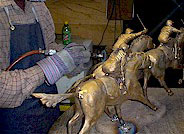 Next,
the sculpture is chased/sanded to remove any sign of welding and to
prepare the bronze for patination. Next,
the sculpture is chased/sanded to remove any sign of welding and to
prepare the bronze for patination.
"PATINATION"
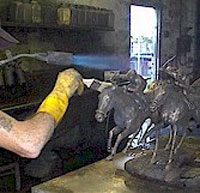 Patinas
actually cause a controlled corrosion to occur that imparts an aesthetically
pleasing color and/or texture while also providing protection to the
bronze metal surface. After the patina is applied with chemicals to
achieve the desired look, the sculpture is sealed with a wax coat to
protect the finish. Alternatively, a glossy coat of high-grade polyurethane
can be applied instead. Some antique and custom patina finishes can
take as long as a week or more to apply! Patinas
actually cause a controlled corrosion to occur that imparts an aesthetically
pleasing color and/or texture while also providing protection to the
bronze metal surface. After the patina is applied with chemicals to
achieve the desired look, the sculpture is sealed with a wax coat to
protect the finish. Alternatively, a glossy coat of high-grade polyurethane
can be applied instead. Some antique and custom patina finishes can
take as long as a week or more to apply!
"MOUNTING"
Finally,
the completed bronze sculpture is mounted on a custom granite or marble
base. As you can see, a lot of work goes in to creating each bronze
sculpture. That is why they are not only extraordinarily fine pieces
of art, but timeless treasures that will be appreciated for generations
to come.
©
2006 Duane Scott Bronze Art
DuaneScottBronzeArt@earthlink.net
|

 The
initial step is to build an armature, typically out of fiberglass. He
then coats the surface with clay. In this picture of "Day's End,"
you can clearly see the brown clay that Duane has already applied to
the bottom half of the surface of the armature.
The
initial step is to build an armature, typically out of fiberglass. He
then coats the surface with clay. In this picture of "Day's End,"
you can clearly see the brown clay that Duane has already applied to
the bottom half of the surface of the armature.
 The
finished clay sculpture is sealed and then a release agent is applied
to make it easier to remove the rubber mold later on. Once the original
sculpture has been prepared, the first coat of rubber is applied by
hand. This step is crucial to obtaining the proper level of detail.
The entire sculpture is covered with an even, thin layer of rubber.
Once the initial layer of rubber has set, additional coats are applied
with "keys" which are used to identify the proper position
of the mold when closed. After the rubber has thoroughly set, a back-up
shell or "Mother Mold" is created out of fiberglass to support
the rubber for the wax pouring process. Next the back-up shell is removed
and the rubber pulled gently back so the original clay sculpture can
be removed. It can take more than 100 hours just to make the mold for
elaborate pieces. After the rubber has been cleaned, the mold is ready
to receive the wax.
The
finished clay sculpture is sealed and then a release agent is applied
to make it easier to remove the rubber mold later on. Once the original
sculpture has been prepared, the first coat of rubber is applied by
hand. This step is crucial to obtaining the proper level of detail.
The entire sculpture is covered with an even, thin layer of rubber.
Once the initial layer of rubber has set, additional coats are applied
with "keys" which are used to identify the proper position
of the mold when closed. After the rubber has thoroughly set, a back-up
shell or "Mother Mold" is created out of fiberglass to support
the rubber for the wax pouring process. Next the back-up shell is removed
and the rubber pulled gently back so the original clay sculpture can
be removed. It can take more than 100 hours just to make the mold for
elaborate pieces. After the rubber has been cleaned, the mold is ready
to receive the wax. A
wax casting is then made by carefully pouring wax into the mold at 160
degrees Fahrenheit. After the wax has cooled, the back-up shell and
mold are removed.
A
wax casting is then made by carefully pouring wax into the mold at 160
degrees Fahrenheit. After the wax has cooled, the back-up shell and
mold are removed. Next
the wax is pulled from the mold and hand chased (re-detailed). Wax rods,
called sprus or gates, are then attached to the sculpture along with
a large cup at one end to allow the molten bronze to be poured into
a ceramic shell which is in effect a "secondary" mold created
for each casting.
Next
the wax is pulled from the mold and hand chased (re-detailed). Wax rods,
called sprus or gates, are then attached to the sculpture along with
a large cup at one end to allow the molten bronze to be poured into
a ceramic shell which is in effect a "secondary" mold created
for each casting. Dipping
the wax in a liquid binder solution, called "slurry", that
hardens as it dries, forms the shell. This step has to be done in a
temperature and humidity controlled room. Since the slurry must be allowed
to dry in between each dipping, this process alone can take a couple
of weeks! Next it is baked in a kiln at 1800 degrees Fahrenheit. As
a result, the wax is "lost" as it melts out of the shell.
After de-waxing, the shell is cooled and inspected.
Dipping
the wax in a liquid binder solution, called "slurry", that
hardens as it dries, forms the shell. This step has to be done in a
temperature and humidity controlled room. Since the slurry must be allowed
to dry in between each dipping, this process alone can take a couple
of weeks! Next it is baked in a kiln at 1800 degrees Fahrenheit. As
a result, the wax is "lost" as it melts out of the shell.
After de-waxing, the shell is cooled and inspected. It
is then re-heated to 1800 degrees Fahrenheit and placed in the pouring
pit where molten bronze is poured into the hollow shell at 2100 degrees
Fahrenheit and allowed to cool and solidify. After removing most of
the shell material inside and out, the unfinished bronze casting is
glass beaded, water or sand blasted to remove any remaining shell material
from the intricate details of the casting.
It
is then re-heated to 1800 degrees Fahrenheit and placed in the pouring
pit where molten bronze is poured into the hollow shell at 2100 degrees
Fahrenheit and allowed to cool and solidify. After removing most of
the shell material inside and out, the unfinished bronze casting is
glass beaded, water or sand blasted to remove any remaining shell material
from the intricate details of the casting.
 Next,
the sculpture is chased/sanded to remove any sign of welding and to
prepare the bronze for patination.
Next,
the sculpture is chased/sanded to remove any sign of welding and to
prepare the bronze for patination. Patinas
actually cause a controlled corrosion to occur that imparts an aesthetically
pleasing color and/or texture while also providing protection to the
bronze metal surface. After the patina is applied with chemicals to
achieve the desired look, the sculpture is sealed with a wax coat to
protect the finish. Alternatively, a glossy coat of high-grade polyurethane
can be applied instead. Some antique and custom patina finishes can
take as long as a week or more to apply!
Patinas
actually cause a controlled corrosion to occur that imparts an aesthetically
pleasing color and/or texture while also providing protection to the
bronze metal surface. After the patina is applied with chemicals to
achieve the desired look, the sculpture is sealed with a wax coat to
protect the finish. Alternatively, a glossy coat of high-grade polyurethane
can be applied instead. Some antique and custom patina finishes can
take as long as a week or more to apply!